Soluciones
La gama de negocios de construcción de caballos se extiende a todo el mundo y sirve a miles de clientes con productos, orientación técnica especializada en construcción, y somos testigos del reinicio de la marca china con ellos.
There are many reinforcement methods of reinforced concrete column, such as enlarging section method, enclosing steel reinforcement method, prestressed strut reinforcement method, displacement method, carbon fiber reinforcement method, etc.
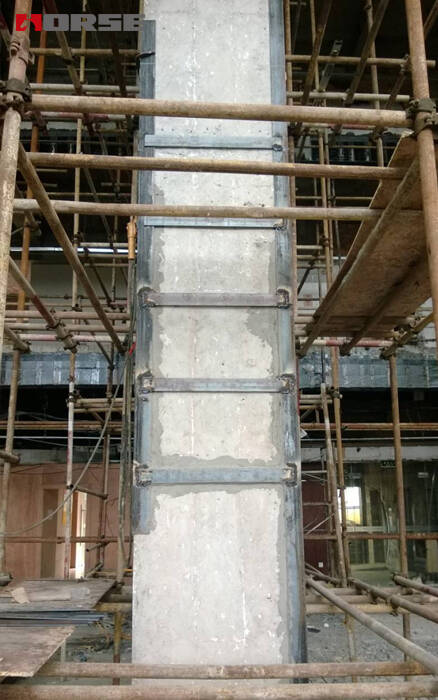
Failure characteristics of reinforced concrete columns
1. The failure modes of reinforced concrete columns can be divided into compressive failure (including axial compression columns and small eccentric columns) and tensile failure (large eccentric columns).
(1) failure mode of axial compression column. The process of axial compression of columns is that the longitudinal cracks which are roughly parallel to the direction of loading appear firstly under the action of larger external loads, and then the concrete in the protective layer is crushed and cracked.
(2) failure characteristics of columns with small eccentricity. When the eccentricity is very small, the cross-section of the column is all compressed, generally near the axial force side of the compressive stress is larger. When the load increases, the concrete on one side is crushed first (longitudinal cracks occur), and the stress of the compressive steel bar reaches the compressive strength, while the stress of the concrete on the other side and the stress of the steel bar do not reach the compressive strength when the member is destroyed.
(3) failure characteristics of columns with large eccentricity. For large eccentric compression columns, transverse cracks first appear on the outer surface of the tensioned column under load. With the increase of load, cracks develop and extend continuously, and the main cracks are obvious before failure. The stress of the tensile steel bar reaches the tensile yield limit, and then the transverse crack in the tensile zone develops rapidly and extends to the compressive zone, resulting in a rapid reduction of the compressive zone area, and finally longitudinal cracks appear in the compressive zone, resulting in concrete crushing failure.
2. reasons for insufficient carrying capacity of concrete. There are many reasons for the reinforcement of the engineering structure, which can be summarized as follows:
(1) False design, poor construction quality, inappropriate use, material ageing in harsh environment and accidental natural violation lead to structural damage, resulting in structural reliability degradation.
(2) because of the change of function, it is often necessary to reinforce the structure. Functional changes may occur in the use stage, but also may occur in the construction stage, at the request of the owner, the developer in the construction process of structural functional adjustment.
(3) the adjustment of national design codes will also become the reason for structural reinforcement. Due to the improvement of design standards, the in use structure may no longer meet the requirements of the existing codes.
(4) reuse of structure for extended service. For projects with cultural relic value, it is necessary to prolong their life through reinforcement.
Common structural reinforcement methods
There are many reinforcement methods of reinforced concrete, such as enlarging section method, enclosing steel reinforcement method, prestressed strut reinforcement method, displacement method, carbon fiber reinforcement method, etc. The following is the most commonly used enlarging section method, enclosing steel reinforcement method, displacement reinforcement method of three methods are described.
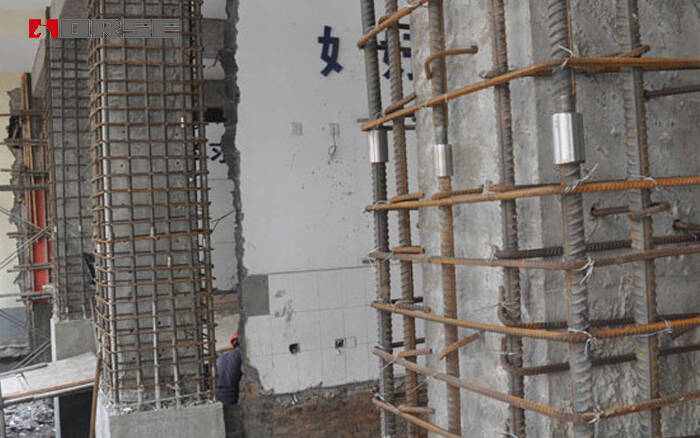
1. Reinforce the reinforced concrete column by increasing the section method.
(1) The method of enlarging section is to use the same material - reinforced concrete to enlarge the section area of the original concrete structure, so as to improve the bearing capacity of the structure. Because the cross-section area and reinforcement of the original column are increased, this method can not only improve the bearing capacity of the original column, but also reduce the slenderness ratio of the column and improve the stiffness of the column. Especially in the seismic fortification area, the original strong beam weak column structure can be changed into strong column weak beam structure which is beneficial to seismic resistance. The specific reinforcement methods include four sides outsourcing, one side thickening and two sides thickening.
(2) construction and construction requirements. In the design and construction of reinforced columns, it is very important to strengthen the combination between the old and new columns, to ensure that they can work as a whole, in order to better develop the redistribution of internal forces between them, give full play to the role of new columns.
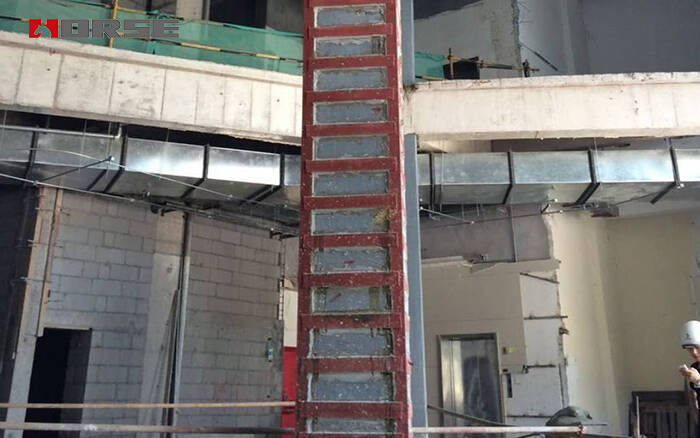
2. Reinforced concrete columns are wrapped with steel.
(1) strengthening with external steel is a reinforcing method for the four corners or two bread of concrete columns. Its advantage is that the section size of the members is not increased much, but the bearing capacity of concrete columns can be greatly improved. For square or rectangular columns, most of them are wrapped with angle steel, and they are connected into a whole with transverse panels. For columns, chimneys and other components, flat steel with hoops is often used.
(2) structural requirements. When the concrete column is strengthened by outer wrapping, the following structural requirements should be met: the edge length of outer wrapping angle steel should not be less than 75 mm. The cross-section of the plate should not be less than 25 mm x 3 mm, the spacing should not be greater than 20 R (r is the minimum revolving radius of single angle steel section), and should not be greater than 500 mm. Outsourcing angle steel must be continuous and continuous, and it is not allowed to cut through all floors. The lower end of the angle steel should extend to the top of the foundation and be bonded with epoxy mortar or epoxy mortar. There should be enough anchorage length at the upper end of the angle steel, and the top cap can be welded with angle steel when possible. When epoxy resin chemical grouting steel is used to reinforce the concrete, the plywood should be tightly attached to the concrete surface and welded with angle steel. After welding, the steel is sealed with epoxy resin, and the air holes are reserved for grouting. When using latex cement mortar to paste the wrapped steel, the plywood can be welded outside the angle steel, and the latex content should not less than 5%. The 1:3 cement mortar protective layer with a thickness of not less than 25 mm should be applied on the surface of profiled steel, and anti-corrosion materials can also be used to protect it.
3. Replacement method for strengthening concrete columns.
(1) When the strength of concrete columns decreases and the bearing capacity is insufficient due to fire or construction errors, it is necessary to reinforce them. Sometimes the size of the columns should not be increased, and sometimes the replacement method can be used as long as the local reinforcement is carried out.
(2) structural requirements. The strength grade of displacement concrete should be determined according to actual calculation. Generally, it should be at least one grade higher than the original design strength grade, and should not be lower than C25. The depth of replacement is determined by calculation. For slabs should not be less than 40 mm, for beams and columns, should not be less than 60 mm, with shotcrete construction, should not be less than 50 mm. The stones used for concrete preparation should be hard pebbles or crushed stones. The size of stones should not be greater than 20 mm when they are replaced locally. The size of stones can be appropriately increased when the replacement depth is large, but the maximum size should not be greater than one third of the replacement depth and not more than 40 mm.
Concluding remarks
After understanding the failure characteristics and causes of concrete columns, appropriate reinforcement methods should be selected according to the appearance of the columns, checking results and site conditions.
Puede encontrar cualquier cosa que necesite, confíe en probar estos productos y encontrará la gran diferencia después de eso.
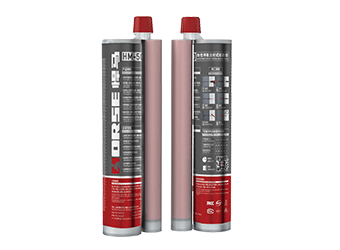
Resina de anclaje epoxi, paquete de cartucho doble. Se inyecta en los orificios con la pistola dispensadora para plantar barras.
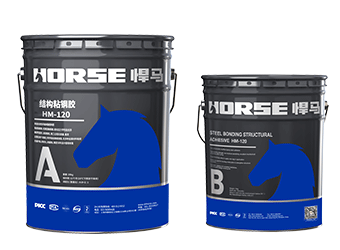
Adhesión de acero y hormigón, utilizada para el refuerzo sísmico de muchos edificios.
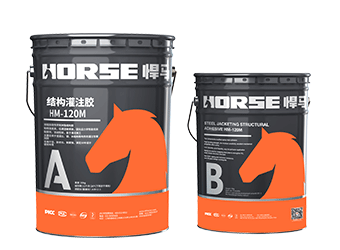
Adhesivo de refuerzo estructural para revestimientos de acero.